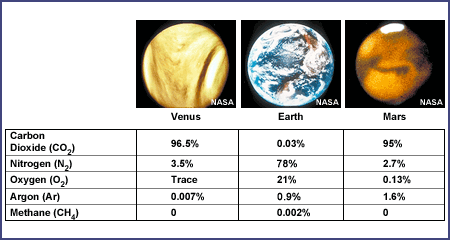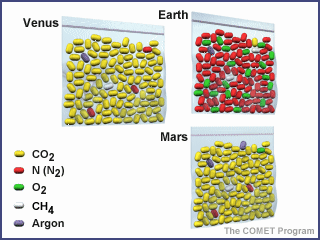Grades Targeted: 6-8
General Objectives: Students will understand that our two closest neighbors, Venus and Mars, have very different atmospheres than Earth does in terms of pressure and composition.
Students will be able to understand the “Goldilocks Principle” and understand that Earth’s moderate temperature is due primarily to its unique atmosphere.
Background: On earth, two elements, nitrogen (N2) and oxygen (O2), make up almost 99% of the volume of clean, dry air. Most of the remaining 1% is accounted for by the inert gaseous element, argon (Ar).
Argon and the tiny percentage of remaining gases are referred to as trace gases. Certain trace atmospheric gases help to heat up our planet because they appear transparent to incoming visible (shortwave) light but act as a barrier to outgoing infrared (longwave) radiation. These special trace gases are often referred to as “greenhouse gases” because a scientist in the early 19th century suggested that they function much like the glass plates found on a greenhouse used for growing plants.
The earth’s atmosphere is composed of gases (for example, CO2 and CH4) of just the right types and in just the right amounts to warm the earth to temperatures suitable for life. The effect of the atmosphere to trap heat is the true “greenhouse effect.”
We can evaluate the effect of greenhouse gases by comparing Earth with its nearest planetary neighbors, Venus and Mars. These planets either have too much greenhouse effect or too little to be able to sustain life as we know it. The differences between the three planets have been termed the “Goldilocks Principle” (Venus is too hot, Mars is too cold, but Earth is just right).
Mars and Venus have essentially the same types and percentages of gases in their atmosphere. However, they have very different atmospheric densities:
- Venus has an extremely dense atmosphere, so the concentration of CO2 is responsible for a “runaway” greenhouse effect and a very high surface temperature.
- Mars has almost no atmosphere; therefore the amount of CO2 is not sufficient to supply a warming effect and the surface temperatures of Mars are very low.
- Mars is much further away from the Sun than is Venus.
 Earth has a very different type of atmosphere. Our atmosphere has much less CO2 than Venus or Mars and our atmospheric pressure is close to midway between the two (1/90th that of Venus and 100 times that of Mars).
Earth has a very different type of atmosphere. Our atmosphere has much less CO2 than Venus or Mars and our atmospheric pressure is close to midway between the two (1/90th that of Venus and 100 times that of Mars).
Many scientists believe that the composition of our atmosphere is due to the presence of life. Life acts to keep Earth’s atmosphere in a dynamic balance. In other words, if life were to completely disappear, eventually our atmospheric composition could come to closely resemble Mars or Venus. Only with life continually producing oxygen through photosynthesis and removing and re-circulating CO2 does Earth’s atmosphere remain fairly stable.
This activity introduces students to the atmospheric differences between the three “sister” planets in a graphic and hands-on way. Students need not memorize the chemical compositions and pressures of the three atmospheres; rather, the activity should give them an overall appreciation of the important similarities and differences. Students will use this understanding later as they begin to appreciate the scope and importance of the greenhouse effect on earth and realize that rather than being a bad thing, the greenhouse effect is critical for the survival of the biosphere
Materials:
- Colored cotton balls, jelly beans, or different colored beans (or similar materials) to represent gases in the atmosphere
- Re-sealable plastic bags
- Science notebooks
Procedure:
- Discuss the “Goldilocks Principle.” Use the information in Tables 1 and 2 to engage the class in a discussion of the greenhouse effect. If available, you may want to share illustrations or slides of Mars, Venus, and Earth.
- After discussing the atmospheres of Earth and the other planets, ask the students (in teams or pairs) to build models of the atmospheres of Earth and the other planets. Emphasize that models are critical tools for planetary scientists trying to understand phenomena too distant to experience directly
- Depending on the material available, ask students to represent the atmospheric gases with different colored beans, cotton balls, or jelly beans. (We will use jellybeans for examples in this activity.) They might represent:
- Nitrogen (N2) with red jellybeans
- Oxygen (O2) with green jellybeans
- Argon (Ar) with purple jellybeans
- Carbon dioxide (CO2) with yellow jellybeans
- Methane (CH4) with white jellybeans
- Representing atmospheric density with jellybeans is impractical – if Earth’s atmosphere has 100 jellybeans, Venus will have 9,000, and Mars will have slightly more than 1/2 jellybean (0.6). Suggest that the students use 10 or 100 as the base number for each planet. Let the students know what the real differences in density are.
- Challenge the students to produce a model atmosphere for each planet by placing the appropriate number of jellybeans in three small, re-sealable plastic bags. The necessary information is provided in Table 2. They will have to translate percentages into numbers of jellybeans, and in many cases, will face the difficulty of cutting the jellybeans into small enough pieces to represent small atmospheric concentrations.

- Have students explain what they found to the class and write about it in their notebooks.
- To extend this activity, you could take one set of bags and distribute the contents in areas measured to represent atmospheric pressure of each planet. For example, the jellybeans representing Earth might be distributed in a meter square. You might have to go outside to find an area big enough to represent the thin atmosphere found on Mars. To concentrate the beans representing the dense atmosphere of Venus, you could use a food processor or mortar and pestle to concentrate the jellybeans.
Assessments:
- Have the students display their work in the classroom and allow time for them to observe and discuss each other’s work as you circulate.
- Have students respond in writing to the following questions in their science notebooks:
- Describe the atmospheric conditions you might encounter as an astronaut setting foot on Venus and Mars.
- Name at least two ways that the atmospheres of Venus and Mars are similar to each other, and one way that both differ from Earth’s.
- What new information did you learn in this lesson? What did you already know? What was the hardest thing about the activity?
Idea taken and adapted from the University Corporation for Atmospheric Research (www.ucar.edu) Introduction to the Atmosphere Activity


